

My Pets of the Past
Although they are no longer physically with me, I will never forget these memorable pets. Some have died, while others were in my care and then released. They are in order of most recently passed on or released.
|
Calico Goldfish #2--- October 2009 - September 6, 2010 I was very sad to lose this fish because it will be the last fish in my life for a long time, maybe forever. It succumbed to some sort of disease, along with its other calico buddy, who died 3 days previously. I tried the medications, but they did not work. We just cleaned this tank about a month ago. I really think that a lot of the bacteria and/or fungi are right here in the water that we are drinking and filling the tanks up with. It is as if the harmful organisms are already there and are becoming resistant to the antibiotics and chemical treatments. I hardly had this fish even a year. Here is the calico on November 1, 2009, the day after the tank received a full cleaning. I had thought about removing CASL Disco because I attributed it to the previous calico's death. However, these photos show that the new calico loved to go inside the CASL and rummage around for food. She knew just how to get in and out with no problem.
Calico Goldfish #3--- January 2010 - September 3, 2010 This goldfish was such good friends with the calico above. They both got a disease in late August 2010 and while they were sick, all they wanted to do was be by each other's side. I remember when Brian first brought this fish home, it would follow the other calico everywhere, hiding itself in her tail fins.
"Red Stripe"/A.K.A. "Whitefish" --- December 2005 - January 14, 2010 This fish was given to me by my good friend, Jeff, in December, 2005. It originally had a large red stripe on only one side of its body, going vertically right down the center. For that reason, it's first name was Red Stripe. But after a year or so, it lost the red stripe and was solid white, and then I started referring to it as Whitefish. This was a great fish, and was quite social. Whitefish loved both of her calico goldfish friends and was devastated when her first calico died . When I first added the new calico, the white fish was a bit confused. I truly think that it remembered its previous calico friend and thought for a minute that it was her. Then it realized it wasn't and started getting a little pushy with the new calico. After a few days, they were hanging out together and swimming back and forth in each other's company and became good friends. You can see them swimming together in the photos below, taken on November 1, 2009 Whitefish was also very hardy. Over the summer of 2009, Brian had purchased a few plecostomi that apparently had some diseases. Whitefish had septicemia (a bacterial infection that made her whole body red from blood), a fungal infection, and anchor worms (a parasitic infection). I had use 3 different medications, but it came back and was in perfect health again. January 13, 2010 was Whitefish's unlucky day. Somehow, it jumped out of the tank while I was at work (there is only about a 4" wide opening too, because I have a hood, but I leave the flaps open so that fungus doesn't grow from the moisture). I found it lying on the floor, totally dried out, fins stuck to the body. Anyone looking at this fish would have thought it to be dead. I was crying and carrying it downstairs and was just putting it into a plastic bag to put in the freezer until warmer burial weather arrived when I saw it's eye move. I didn't know how this fish could possibly still be alive, but I figured it was worth a shot. I lowered it into the tank and some bubbles came out of its mouth, and then it started moving its mouth and one gill flap. The other gill flap was stuck shut from being dry, so I had to carefully pry it open with my finger while it was in the water. Its fins were still stuck to its body so it couldn't swim. I stabilized it on the ceramic house in the tank and it started breathing more regularly. It was covered in fuzz from the carpet and the slime coating was just coming off in strings. It's fins were just ravaged. I told Brian it would be a miracle if it survived. In fact, I was even going to re-name it Miracle. It made it the 14 hours until I had to go to work the next day, but looked terrible. I saw more reddish streaks in its tail, so I decided to put in some antibiotics and antifungal medication. I wanted to do this yesterday, but I thought that those chemicals might burn the fish, not having any slime coating anymore, so I wanted to wait a bit. I don't know if I waited too long or if the fish wasn't going to make it anyhow, but when I came home from work on the 14th, Whitefish was still in the same spot where I stabilized her, still upright, but was dead. It's calico friend was right by its side, as it had remained all last night. The calico didn't even prod at it or try to peck at it like some fish would. They were good friends. I will really miss Whitefish. This experience has changed how I will determine if a fish that has jumped out is truly dead, as one cannot judge this by the fish's appearance or lack of movement. I sure hope that in the past, I didn't prematurely put fish in body bags that were actually still alive. Whitefish had to have been out of the water for at least an hour to be that dry. That means that people that go fishing and think they are killing the fish in a few minutes by leaving them out of water may be very wrong. A fish's death by "suffocation" may actually take hours, rather than minutes, and may be more torturous than people assume.
Rubber-lipped Plecostomus --- October - November 2009 Although I didn't have this plecostomus for long, it was still a favorite and will be missed. Here it is in CASL Disco.
Calico Fantail --- 2005 - May 12, 2009 This was one of my favorite fish ever. I have never had a goldfish with such beautiful coloration. She was so graceful in the water and I loved the way her eyes would move when she'd watch you while resting at the bottom. I found her dead on May 12, 2009, inside CASL Disco, where she had never ventured before. Somehow, she got herself into the area where the face is and must have kept trying to go forward. I think because she was so wide, she just couldn't use her gills well in that area and panicked and/or suffocated. I can't believe that one of my artistic creations caused her demise. I made that decoration especially wide so that nothing like this could happen. 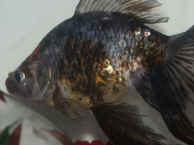
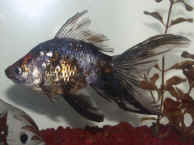

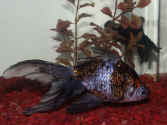
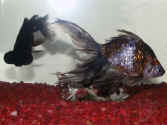
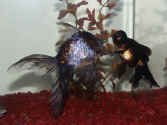 Calico Fantail Goldfish alone and with
Black Moor that has since passed on, 7-25-06
The calico goldfish in the foreground is actually
dead in the photos below, but since I had never gotten a photo of it with
its friend, the white comet, I took these photos anyways. These
fish were very good friends. I got them both (and the black moor
above) from one of my good friends, Jeff, when he decided to dismantle
his freshwater tank and go all saltwater in December, 2005. These fish used to rest at the bottom, side by side.
The fantail would follow the white one around other times. The
white fish was so depressed after she was gone that it didn't even swim around
the tank much. After the addition of a pleco (that later died), the white
fish ended up getting very sick and had 3 different diseases. I had to use
3 different treatments on it---one for fungus, one for bacteria, and one for
parasites. Luckily, it survived. In October 2009, it received a
new friend.
Calico Fantail Goldfish alone and with
Black Moor that has since passed on, 7-25-06
The calico goldfish in the foreground is actually
dead in the photos below, but since I had never gotten a photo of it with
its friend, the white comet, I took these photos anyways. These
fish were very good friends. I got them both (and the black moor
above) from one of my good friends, Jeff, when he decided to dismantle
his freshwater tank and go all saltwater in December, 2005. These fish used to rest at the bottom, side by side.
The fantail would follow the white one around other times. The
white fish was so depressed after she was gone that it didn't even swim around
the tank much. After the addition of a pleco (that later died), the white
fish ended up getting very sick and had 3 different diseases. I had to use
3 different treatments on it---one for fungus, one for bacteria, and one for
parasites. Luckily, it survived. In October 2009, it received a
new friend.
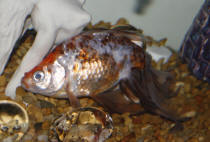
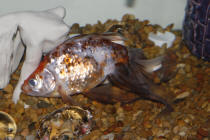
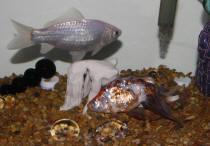
 May 12, 2009
May 12, 2009
|
Flo: 2001 - December 20, 2007
Eddie: 2001 - April 3, 2009
I used to have two parrotfish that I purchased in 2001. They were only about an inch and a half long when I got them, but they grew very large over the years. After death, I measured Eddie to be exactly 7 inches. He weighed 6.6 oz. There was a plecostomus that lived with them for a few years. In April of 2006, the plecostomus and Flo got very sick. They were covered in lesions, fungus and bacteria. I tried every medication out there since it seemed like they had multiple infections. I placed the hospital tank right next to the regular tank, where Eddie was still living. Eddie would not leave the bottom of the tank (which was where it could see Flo). He didn't eat much for weeks because he wouldn't let Flo leave his sight. I couldn't believe what a strong bond these two fish had. I've never witnessed anything like that. Finally, the last medication I used cleared up all of the problems and both fish were returned to the tank. The parrotfish did some type of "dance" where they swam in circles over one another for about a half hour. They were very happy to be reunited. Later, the plecostomus became carnivorous in the spring of 2007 and had to be removed. Sadly, it was too late for Flo, whose skin must have been scraped too badly by the plecostomus that it died. Eddie was never the same and was quite depressed. Without a plecostomus, quite a heavy algae problem was developing, so a new one was added again in March 2009. He didn't seem carnivorous, but he must have had a disease because about a week later, Eddie was on the bottom and had white spots on his body. I got the proper medications and tried to treat him, but he died.
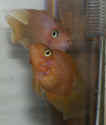
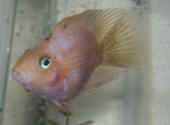 Flo and Eddie (Parrotfish), 2004
Flo and Eddie (Parrotfish), 2004
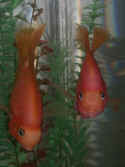
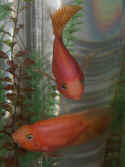
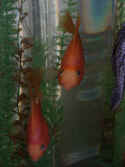
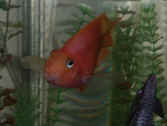
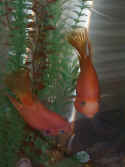 7-25-06
(for some reason, they truly were a darker
orange color for these pictures)
7-25-06
(for some reason, they truly were a darker
orange color for these pictures)
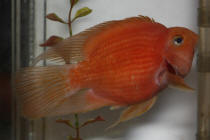 Flo on 5-31-08
Flo on 5-31-08
Click here to see a movie of the parrotfish! If you don't have a movie player, you can download a free one at Quicktime.com. |
Glass Fish --- 2002 - February 2009
This glass fish was amazing. Normally, these fish swim in schools, but not this one. It didn't mind being the only one in the aquarium with two goldfish, a loach and a plecostomus. This fish fought off several bouts of fungus and bacterial diseases, eventually lost its antennae (but would grow them back to some extent), and fought hard until the end. I have never had one of these fish survive this long. I had actually purchased two others when I bought this one and they died within a few months.
"Little Wing" --- Baby Duckling (June 29-30, 2008)
Brian and I were driving home down Hines Drive at about 10:15 at night when he spotted something in the road he thought was a fledgling and said that we had to turn back. When we did, at first I thought I saw a sandpiper running to the right side of the road. When we pulled over, it started running for the other side and nearly got hit by a car coming the other way. I could then see that it was a lost baby duckling. I remembered swerving to avoid what I thought was a sandpiper just a few days ago---it was probably also a duckling. For some reason, the way they walk or something, at night, they look like sandpipers. Anyhow, when I was finally able to cross the road (about a minute and a half), I found it and captured it and brought it back in the car. There was no sign of its family. It was dark and cold and there was no way it would survive the night without a heat source. I knew that much, although I've never had a baby duckling before in my life. I was sad for it that it lost its family, but I was ready to commit to keeping it for its whole life if that was what was necessary for its survival. I was really looking forward to raising this duckling. It was preening and trying to clean its feathers of all the muck it was covered in from running around in the ditches at the side of the road, so I bathed it and hair-dried it (just its bottom half that was dirty). I didn't think it should ingest any more of whatever was on its feathers. I read all about baby mallards on the internet. Unfortunately, I couldn't get the recommended Mazura Wildfowl Starter food (or something similar) until the following day because there was nothing open. I tried to feed it the also suggested bits of dandelion greens and small bread crumbs soaking in a shallow dish with water so it wouldn't choke. I put the heat lamp on and made sure it was at 90 degrees Fahrenheit like it should be (the duckling appeared to be only a few days old). It didn't want to eat or drink, so I tried to at least give it water on the side of its beak with an eyedropper. It did swallow a bit down. I stayed up for much of the night with it, until about 5 am. Then I had to get some sleep. Brian found it in the morning when he got up for work at 7:15 and it was laying on its side in the water dish. All of its feathers were completely soaked. He woke me up and I hair-dried the duckling and got it fluffy again, but it was still shaking heavily. I used a very low setting on the drier to not dry it too quickly, yet not heat up the bird too fast. I did what I thought was best, but I think the damage had been done. I held it in my hands to help warm it and comfort it for about 45 minutes. It seemed to be doing better, so I put it back in the bin. I had to get some sleep, so I went back to bed. When I got up 4 1/2 hours later, it was dead and rigormortis had already set in. I felt horrible for not staying up longer and at least holding it the whole time. I have been all torn up about this and trying to figure out how it could have done that to itself when I watched it hop in and out of that dish---it's even shown on one of the videos. Everything I read said how important it was to provide water for the bird to play in or it wouldn't be acclimatized properly to life on its own if it decided to leave, so that's why I left the dish in. I was only away for two hours---I wouldn't think it could do that to itself so quickly---it was sleeping when I left it because it seemed so exhausted from running around searching for its family for who knows how long. Anyhow, I've been thinking all day what could have gone wrong and when I watched one of the videos today, it came to me---in one video, it pokes at the side of the cage---I think it saw its reflection. It probably saw itself while it was in the water dish and wasn't even trying to get out of the water---it was probably trying to get through to the "other bird" it saw. I didn't have any cardboard boxes around and I figured they would just get very dirty and wet, so that was why I put it in a large rubbermaid tub. I think that was the whole problem. If anyone is trying to raise a duckling all by itself, keep it in a completely opaque (non-see-through) box. Don't put anything reflective near its water dish. Otherwise, it will not leave the dish and will try to get to the "other bird" and could die. The poor thing was lonely. If only I could have been there. Unfortunately, I have no pictures, only a few movies. I was going to take pictures the following day when it was rested---I figured it had been through enough.
Here is Little Wing chirping and jumping in the water.
Here is Little Wing sleeping.
Xenopus laevis---African Clawed Frog #2 (1990-May 31, 2008)
One would think I would have named this frog, after having it for 13 years, but I didn't. I only knew it by the patterns on its back (and I must say, it was my favorite). This frog was actually about 20 years old when it died because it was about 7 years old already when I received it from someone who had cared for it up until that point. I guess that's a long life, but it was still sad to wake up to find it dead, leaving my other xenopus all alone.
Snail (Feb-May 2008)
I didn't have this snail for long, but it sure was a joy to watch while it was alive. It lived in the tank with my parrotfish, Flo. I was glad I got the few photos of it. About a week earlier, I had discovered it raising this tube up to the surface and it appeared as though it was breathing air (one could see its muscles contracting in and out). I never knew snails did this.
Plecostomus (2004-March 2008)
I really used to like this plecostomus. It had beautiful patterns on its underside. It used to live with my parrotfish, where it is photographed here. But it became carnivorous, as I am finding with about 25% of the plecostomi I've had in recent years. Once they get a taste for fish, they never seem to want to go back to scraping the sides of the tank for algae, let alone eat an algae wafer dropped into the tank. He had to be separated, and lived a lonely life by himself.
Xenopus laevis---African Clawed Frog #1 (1990-July 10, 2007)
Originally, I had three frogs of the same age. Now, there is only one of these original frogs left. This frog was about 17 years old when it died. My air conditioning went out and the temperature was a constant 90 degrees Fahrenheit in my home for almost 2 days. I didn't think to do anything for the frogs because I figured they are from Africa and could tolerate the heat. Apparently not---I'm assuming these were probably lab-bred and therefore the heat-resistance genes might have been bred out of them. In any case, I was very sad because I was hoping to have this frog many more years.
Black Moor, (?-March 27, 2007)
This fish was given to me by my friend, Jeff in December, 2005. Although it didn't live long with me, it was a very nice fish. I've always liked black moors, but they seem very susceptible to disease. Near the end of this one's life, it was having trouble staying down in the water---it kept floating to the top. I tried medications, but nothing worked. Then I noticed a bunch of strange whitish-clear rounded colonies of something on the bottom of the tank (I didn't put any gravel in the hospital tank). The day I removed it from that tank, it started swimming around and doing better. The next day, it was dead.
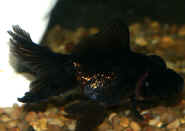

 Black moor, spring 2006 (photographed while residing in a different
tank),
and 7-25-06 with calico goldfish.
Black moor, spring 2006 (photographed while residing in a different
tank),
and 7-25-06 with calico goldfish.
|
Blue Botia (1996-November 17, 2006) and Plecostomus
One of my favorite types of fish were my blue botias. I had the botia pictured below since about 1996. He was more than 14 years old! I had 2 more that made it to the ripe old age of 16. They were very elusive and I rarely saw them, except at feeding time. They preferred to stay in their dark CASL Disco home that I made for them out of clay after the real CASL Disco designed by Bruce Bickford. You can read more about the creation of their home on the Ceramics Page. Also found dead on the same day was the plecostomus that resided in the tank with him. I don't remember how many years I had the plecostomus.
Little Toad (2004-November 16, 2006)
Little Toad lived with Frank and Big Mama in a terrarium for the past year. The previous year was spent in my classroom, educating students that they can't actually get warts from touching a toad and allowing some students to make friends with an animal they may not have otherwise approached. This toad was always a bit strange and seemed slightly brain-damaged. It wasn't scared off by movement, like it should have been, so it was a good match for students to enjoy since it didn't try to get away. It did a lot of staring into space---more than a usual toad would do, anyhow. At the beginning of November, it stopped moving much at all. For about 5 days before it died, it was unable to move at all. Sometimes its throat would stop moving for up to 20 seconds. It was very sad to watch this go on for so long, but I wasn't able to put it out of its misery with my own hands either.
Garter Snake, Thamnophis sirtalis (2005-2006)
In the fall of 2005, my dad caught a garter snake and brought it over. I wasn't intending on keeping it for too long, but it ended up staying with me throughout the winter. It is now 3-4 times the size it was when it arrived.
On May 5th, it shed its skin, making its colors more brilliant than ever. Its eyes are sparkling and I can see my reflection in many of the photos. I also took a movie of it, but I accidentally shot it sideways. You can see the snake breathing and resting.
Click here to see the snake movie.
On July 13, 2006 the snake was released at the Henry Ford Estate in Dearborn, MI. I took a few photos of it before it crawled into the vegetation. Brian is also pictured holding it for the last time. This snake helped him get over his fear of touching and handling them as he was its sole caretaker for the past year.
A bullfrog tadpole was brought in by a student in January 2005. He had it in a fish tank for two years and all it had developed were some very tiny (about 3/8" long) hind legs. During this time, it was eating only fish food. I raised a bullfrog tadpole about 20 years ago and I fed it boiled spinach. I did the same for this one and it started growing at an amazing rate. Within 12 weeks, its front legs had already developed and the hind legs were getting large and muscular. In the first four pictures, the tadpole almost resembles an adult frog except for it's narrow mouth and long tail. The last five pictures were taken one week after the first series. You can see how the frog's body is more slender, the mouth has widened and the tail is smaller. It is now a large frog, as shown in the pictures underneath the tadpole, taken on May 30, 2006 and June 10, 2006 (the last six). I never knew they could grow that large in just a year! On July 13, 2006, he was released at the Henry Ford Estate.
Kuhli Loach (2003-2006)
Bubble Eye Goldfish (2003-2006)
Big Mama was a huge toad given to me by a friend in September 2001. I am not certain if she was a Fowler's or American toad, as they are also known to hybridize, or crossbreed. She passed away on November 26, 2005. I think she may have eaten a yellow sac spider because her tongue was not extending as far as it should and she was having difficulty eating for about a month before she died. These symptoms were similar to those that one of my pet chameleons experienced before it died. Of all of the toads I've ever had, she was definitely my favorite. I will miss her.
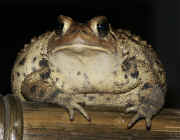
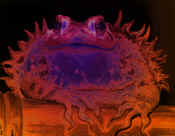 August 2003
The second picture was modified in Photoshop.
August 2003
The second picture was modified in Photoshop.
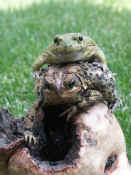 Frank
on top of Big Mama, 2003
Frank
on top of Big Mama, 2003
|
Xenopus laevis---African Clawed Frogs (1990-2005)
I obtained three of these frogs in 1996 from a former teacher who had them since 1990. Sometime after 1998, I bought two more, a highly spotted male, and an albino male. The large female and albino male pictured below passed away from bloating disease and other bacterial infections. I mistakenly fed them minnows thinking they would be good for them. I was not aware that these frogs suffer the same types of diseases as freshwater fish. After numerous medicinal treatments, I was able to save the other frogs.
Butterfly Fish (2003-2005)
[ Lyle Sundog Gordon ] [ Darwin, the Amazing Border Collie ] [ Dogs of the Past ]
[ Don the Spadefoot ] [ Frank the Spadefoot ] [ Other Spadefoots ]
[ Twista the Dancing Clawed Frog ] [ African Clawed Frog Development ]
[ Pet Toads ] [ Wild Detroit Toads ] [ Wild Metro-Detroit Toads ]
[ Bunny Boy ] [ Beatrice the Mallard Duck ] [ Caring for Abandoned Sparrow ]
[ Past Fish and Other Pets of the Past ] [ Pepper Loach ] [ Box Tortoises ]
[ Biglegs the Jumping Spider ] [ Tufts and Mr. Greenfangs ] [ Radinka the Platycryptus undatus ] [ Caring for Jumping Spiders ]
[ Home ] [ Artwork ] [ Photography ] [ Art Cars ] [ Virtual Museum ] [ Pets ] [ Favorite Links ] [ What's New / My Blog ] [ Guestbook ] [ For Sale ]
Copyright © 2004-2024 kozmicdreams.com. All rights reserved.
All materials contained on this site, including text, graphics and icons, are the property of
kozmicdreams.com.